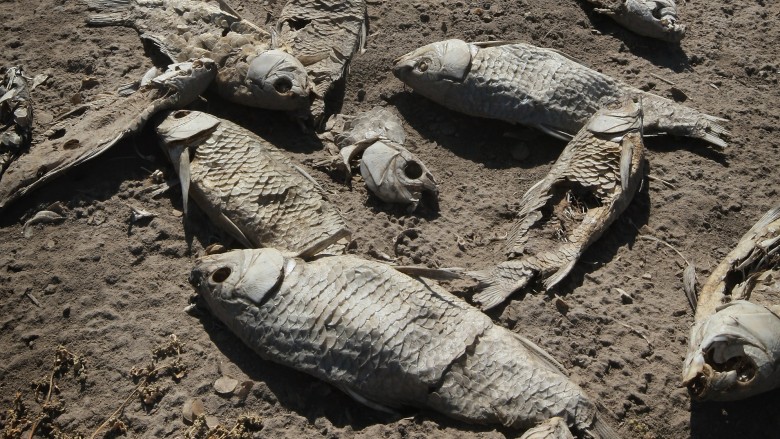Insane Diseases You Definitely Don't Want
Sickness can mean an annoying cold or conditions more serious like cancer or dementia. But then there are the truly crazy diseases, the ones that whiz past mundane and tragic into the realm of nonsensical nightmares. Luckily, most of us will never suffer from these issues since they occur so rarely, but always remember that there is still a chance they might happen to you.
Grab a trash can. Some of these might make you queasy.
Brainerd diarrhea
Brainerd diarrhea isn't the sort of upset you get after eating the last hot dog in the machine at a 7-11. This severely debilitating explosive diarrhea lasts for months.
Brainerd diarrhea's name is taken from the town it first appeared: Brainerd, Minnesota. In 1983, several people in the town became sick with sudden explosive diarrhea, and there appeared to be no observable cause. Most of the victims had gone to the same restaurant before their symptoms appeared, but that's pretty much where the trail ends.
There have been eight further outbreaks, none of which yielded any further information or insights. Raw milk and untreated water can cause intestinal problems but never for the extended periods of time that Brainerd diarrhea does. So there you have it: mysterious months-long diarrhea that has no cause and randomly appears in no certain pattern. But if you think you have it right now, don't worry. That's probably just you soiling yourself with fear.
Trimethylaminuria
Trimethylaminuria (TMAU) causes patients to smell badly of rotting fish. TMAU is extremely rare, with only 600 documented cases around the world, but for those who have it, it can be pretty distressing because a large number of those in the medical community have no idea what TMAU is. Sufferers likely go years with a cloud of stink following them without knowing what the heck they have.
TMAU, the result of a faulty enzyme, is signaled by the buildup of a volatile chemical known as TMA. Most people don't have so much TMA, but those with TMAU can't break it down, causing it to seep into their lungs and into their breath, out of their pores through sweat, and onto their skin. The chemical is in just about all foods from eggs to beans to most dairy products. To treat TMAU, patients adopt highly restrictive diets and need medicines that aid in breaking down TMA. Oh, and lots of showers and deodorant.
Fatal familial insomnia
Most of us have had nights where we just couldn't get to sleep, but fatal familial insomnia goes on for eight to nine months until you just die. The disease is genetic, and it is so well documented in certain families that it can be traced back to a single Venetian doctor from the 18th century. The symptoms usually start with tremors, impotence, and constipation, before moving on to total sleeplessness. What little rest these patients get is a sort of hazy fugue state where they can be observed making "miming" moments, sort of like sleep walking or like using your computer before your morning coffee.
So far, nothing can be done for those with FFI. It's resistant to strong sedatives and other therapies. There has been a recent breakthrough, however, with finding what causes FFI: a misshapen prion that targets the thalamus. The thalamus controls functions like temperature and blood pressure. Whenever patients try to sleep, the thalamus raises the blood pressure instead of lowering it, causing them to be hyper vigilant.
Despite knowing what causes FFI, there's still no treatment. So ... sweet dreams!
Fibrodysplasia ossificans progressiva
When we tear a muscle or get a bruise, it's just a little inconvenience for a day or two, but for people with fibrodysplasia ossificans progressiva (FOP), it can have dire consequences. FOP makes you grow a second skeleton. Every time a muscle tears or gets injured, rather than sending cells to heal the area, new bones form and freeze you in place like a statue. Only one in every two million people will have this nightmare, so that's kind of good. But you know what that means: because it's so rare, 90 percent of patients will be misdiagnosed, and there are currently no treatments.
The very first report of FOP comes from 1736, when a doctor in London described a patient suffering from abnormal bone growth. Since then, we've discovered the condition usually begins at five years old, and most patients will lose all upper body mobility by the age of 15. Pretty much any damage to muscle fibers can cause bones to grow. Even getting a flu shot is enough to activate it.
Though we still don't have a treatment, geneticists have been able to discover certain mutations that could possibly enable an effective solution for the future. In the meantime, just be sure to avoid eye contact if you ever happen to meet Medusa.
Tree man syndrome
It's pretty easy to treat a wart. You just freeze it off then wear a Band-Aid for a few days, but imagine if you had giant warts all over your body and, oh, they look like tree bark.
For those unfortunate enough to have tree man syndrome (or epidermodysplasia verruciformis), you have these giant warts all over your body, and in many cases they make you completely helpless. Up until this year, all four documented patients with tree man syndrome were men, but recently, a girl in Bangladesh was found to be the first female with the condition. The warts are the result of a vulnerability to human papillomavirus, which most humans can manage effectively, but these unfortunate folks can't.
Tree man syndrome doesn't start manifesting until later years. One man with the disease grew an astounding 11 pounds of warts, which left him unable to work or even hold his daughter, but through extensive efforts and a total of 16 operations, he was able to have all of the growths removed. He is believed to be the first person cured of tree man syndrome. There's a chance the warts will grow back later, but for now, he's enjoying being able to walk on the street again without random dogs peeing on him.
Stevens-Johnson syndrome
Imagine all your skin peeling off like the that scene from Poltergeist. That ... is not really useful in picturing what Stevens-Johnson syndrome is. Because Stevens-Johnson syndrome (SJS) is worse.
SJS causes the entire top layer of skin and mucous membrane to start peeling away and that even includes your eyes, lips, and internal organs like your lungs. And we have no real idea why it happens. There are several ways that SJS can be activated: an infection, or by a crazy number of common drugs like anticonvulsants, penicillin, sulfa drugs, aspirin, naproxen, and ibuprofen.
SJS occurs in two to seven people per million, and it's commonly misdiagnosed because it begins with flulike symptoms. So when the skin peeling starts, it's completely unexpected. In its worst form — toxic epidermal necrolysis — there can be blisters on 30 percent of your body and risk of death ranges from 25 percent to 50 percent. There is no cure, and doctors can only treat the symptoms until skin (hopefully). grows back People who do recover from SJS can be left blind and severely scarred and ... ouch, this is just depressing with no hope at all, so let's move on.
Achalasia
With achalasia, every time you eat or drink, you can get incredibly sick with intestinal distress. Over time, the nerves in the esophageal wall disappear, making food unable to pass through the esophageal sphincter. It builds up, causing patients to become incredibly sick.
So far, we think the immune system makes the false response of mistaking the esophageal nerves for viruses and attacks them, rendering the esophagus incapable of handling food. The only treatment is invasive procedures like surgery or putting a balloon in your esophageal sphincter. The bad news is this treatment does not address the disease's mysterious cause, but the good news is it at least sounds pleasingly kinky.
Encephalitis lethargica
In the 1920s, a plague hit millions. Known as encephalitis lethargica, the disease was a total mystery that disappeared as suddenly as it arrived. It killed nearly a million people and left others in a permanent waking coma.
What's even more terrifying is that the disease is making a resurgence. In the '90s, several people started exhibiting crazy symptoms, starting with shaking, high fever, and hallucinations, leading to either death or a coma-like state that required full-time care. When their brains were examined, it was found that they all had the disease that was long thought to have died out.
Up until then, encephalitis lethargica had no known cause. It was thought to be related to a severe strain of the flu, which had struck before the lethargica plague appeared, but researchers couldn't discover a link. However, a crazy pattern was found. Researchers realized that all of the patients who came down with the disease had suffered from something that was almost laughably innocuous: strep throat.
They'd had a rare mutant form of strep that caused the immune system to turn on itself and start destroying their brains, leaving them pretty much as statues and unable to function. So all those kids who pray for strep throat so they can get out of school for a few days may have their prayers answered — by their brains trying to kill themselves, leaving them a drooling zombie.
Parry-Romberg syndrome
Remember that scene from Raiders of the Lost Ark where all the Nazis' faces started melting off? Parry-Romberg syndrome is sort of like that except to only one side of your face. It starts with ordinary looking scars on the skin. Oftentimes, it can be mistaken for a bruise or a birthmark. However, it progressively gets worse, as one side of your face deteriorates and distorts until you finally realize you might need to go see a doctor.
To make it even more of a doozy, the disease can be accompanied by neurological problems like seizures and severe migraines. There's been some progress in treating the disease with the cancer drug methotrexate, but it doesn't work for everyone. Another solution is reconstructive microsurgery, where the patient's fat and sometimes stem cells are used to try to rebuild the face. If you can't do either of those, your only option is to become the district attorney of Gotham City.
Epidermolysis bullosa
Epidermolysis bullosa is known as the "butterfly disease" because a sufferer's skin is said to be as delicate as a butterfly's wings. Despite this almost poetic description, the disease itself is just horrifyingly awful.
This connective tissue disorder makes your skin incredibly fragile. Brushing your teeth? Better make sure you don't brush anything other than your teeth, otherwise you're going to rip your mouth up like you were eating broken glass. All tissue both inside and outside of your body is vulnerable, and in severe cases, a bone marrow transplant is required to try to help your cells make protein.
This condition occurs in one in every 50,000 births, and there's an estimated 27 different varieties of the illness. Most babies born with disease will die quickly from internal complications. A few make it to adulthood, but it's pretty unusual, and there's little hope of living an ordinary life. So if you yourself have made it to adulthood in good health, be thankful.
Seriously. The next time you stub your toe, don't swear. Yell, "Thank you!"


